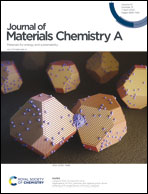Boosting energy storage performance of BiFeO3-based multilayer capacitors via enhancing ionic bonding and relaxor behavior†
Abstract
Environmentally friendly BiFeO3 capacitors have great potential for applications in pulsed-discharge and power conditioning electronic systems because of their excellent intensity of spontaneous polarization (Ps). Herein, (0.7−x)BiFeO3-0.3BaTiO3-xNaTaO3 + 0.3 wt% MnO2 (abbreviated as BF-BT-xNT) multilayer ceramic capacitors (MLCCs) were designed and prepared to improve the energy storage performance via enhancing ion bonding and dielectric relaxation. The BDS of BF-BT-xNT MLCCs from 500 kV cm−1 at x = 0.05 increases greatly to 800 kV cm−1 at x = 0.15 due to the increase of the band gap and resistance, and the decrease of dielectric permittivity. An excellent energy storage density Urec = 9.1 J cm−3 and efficiency η > 80% were obtained since ultrahigh BDS (780 kV cm−1) and low Pr value (2.1 μC cm−2 at measured electric field 780 kV cm−1) were achieved simultaneously in BF-BT-xNT multilayer capacitors at x = 0.12. This work provides a strategy for improving energy storage properties of BiFeO3, which is via enhancing ionic bonding and relaxor behavior to achieve high BDS, low Pr and large Pmax, simultaneously.



 Please wait while we load your content...
Please wait while we load your content...